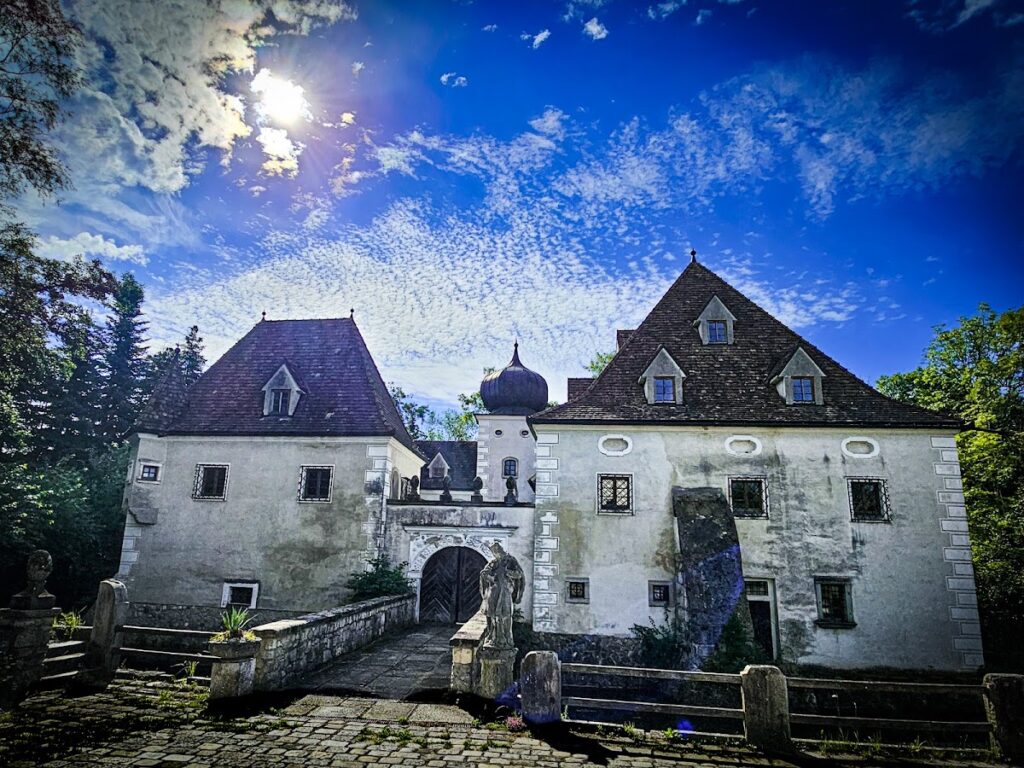Wasserschloss Hueb: A Moated Castle in Hueb, Austria
Visitor Information
Google Rating: 4.5
Popularity: Very Low
Google Maps: View on Google Maps
Country: Austria
Civilization: Unclassified
Remains: Military
History
Wasserschloss Hueb is located in the municipality of Hueb, Austria. This moated castle was originally established during the medieval period, reflecting the feudal structures of the region.
The earliest recorded mention of Wasserschloss Hueb dates to 1356, when the estate was held as a fief by the Volkensdorffer family and granted to Eberhard Mühlwanger, a city judge of Steyr. Over time, ownership passed to the brothers Siegmund and Heinrich Prueschenk, who served as feudal lords of the castle. By the early 16th century, in 1525, the property came into the possession of the Sproll family. A few decades later, in 1557, Daniel Luger, a citizen of Steyr, became the new owner.
During the late 16th century, specifically around 1588, the castle gained historical attention when high taxes imposed by Urban Johann Steurer’s son sparked a peasant uprising. This unrest affected not only Wasserschloss Hueb but also neighboring estates at Eggendorf and Leompach, illustrating the tensions between local nobility and peasants.
The castle’s ownership changed hands several more times in the following centuries. Klaudius Philipp Pröller von Ladendorf acquired the estate in 1608. By mid-17th century, Johann Friedrich Mörk von Gneisenau was recorded as lord in 1650. Afterwards, the ecclesiastical authority of Schlierbach Abbey held the property, followed by Ehrenreich von Schallenberg, who consolidated Wasserschloss Hueb with the nearby estate of Eggendorf.
Towards the end of the 17th century, the castle suffered extensive fire damage. The estate was subsequently rebuilt around 1700 during the tenure of Wolf Spiller von Mitterberg, who owned it between 1696 and 1709. This reconstruction gave the castle much of its present form.
In the 20th century, Wasserschloss Hueb entered a new phase when the Wiesmayer family acquired it in 1956 and operated a tavern on the site. Ownership changed shortly thereafter in 1961 to the Wimmer family. Currently, the castle is under private ownership by Erwin Machgraber, an antiques dealer from Marchtrenk. Mr. Machgraber is engaged in restoration efforts aimed at preserving the historical character of the structure.
Remains
Wasserschloss Hueb is characterized by its classic moated design, featuring water completely encircling the castle. The moat is crossed by a stone bridge, which bears a statue of Saint Nepomuk, a figure traditionally associated with protection against floods and water dangers, reflecting the cultural symbolism often linked to such water-bound estates.
One distinctive element of the castle’s structure is a projecting turret located at one corner of the building. At the rear façade, a large tower rises prominently, crowned by an onion dome roof, a style commonly associated with Baroque architecture in Central Europe. This tower includes open arcades on both its ground and first floors, supported by robust granite columns, which add to the visual elegance while serving structural purposes.
Adjacent to the tower on the first level is an open terrace enclosed by a balustrade made of granite, offering an outdoor space that historically may have served leisure or defensive functions. Surrounding the castle is a park containing several stone sculptures that enrich the setting. Among these are a religious group depicting Mary as Queen of Heaven with the infant Jesus and angels, Baroque-style figures, and representations of lions, underscoring the artistic tastes prevalent during the castle’s later decorative phases.
Today, the castle appears unoccupied and shows signs of needing renovation, although conservation work is underway to restore the building in a manner consistent with its historical significance. The combination of water defenses, sculptural park elements, and distinctive architectural features highlights the layered history preserved within the site.







